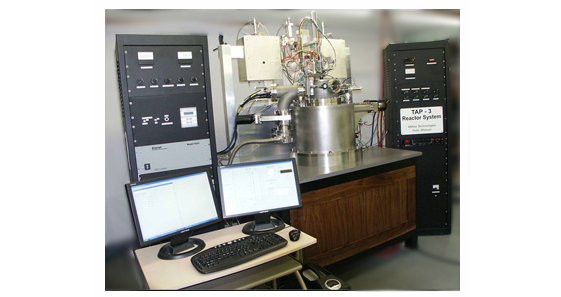Temporal Analysis of Products
The Temporal Analysis of Products (TAP) Reactor System is used to characterize the reaction kinetics of chemical conversion over heterogeneous catalysts. The TAP experiment is performed under ultra-high vacuum conditions using a technical catalytic material direct from an industrial reactor. A small pulse of reactant/inert gas mixture (10 nanomols) is injected into the reactor. The pulse response exit flow is detected by a mass spectrometer.
A recently completed commercial TAP-3 system. This system was built for an industrial catalyst development group here in the U.S. The TAP-3 design evolution includes unattended experiment automation, a redesigned rotary valve that isolates the reactor from the vacuum system, and an improved vacuum system design that minimizes the 'machine function' of the mass spectrum background. The rotary valve allows the user to switch between vacuum pulse response and high pressure flow experiments on the same catalyst sample.

One of our newest design evolutions includes an upgrade of the quadrupole mass spectrometer to a time-of-flight mass spectrometer. Now the entire mass spectrum may be sampled in a single pulse with improved mass resolution. This TAP system uses an Angular Reflectron Time-of-Flight Mass Spectrometer with a microchannel plate detector from Jordan TOF Products, Inc. This system is scheduled for delivery to a European academic facility in early 2013.
Another TAP-3E machine currently under construction is designed to expand the TAP kinetic characterization technique to other commercially available spectroscopic and surface modification techniques. It includes an atomic layer deposition module where catalyst surface composition can be modified in submonolayer quantities. Catalyst samples are loaded and transported pneumatically to avoid exposure of deposited samples to the ambient before kinetic testing. This machine includes two 8-position microreactor carousels used for advanced testing of multiple samples. This system is scheduled for delivery to a European academic facility in late 2012.

